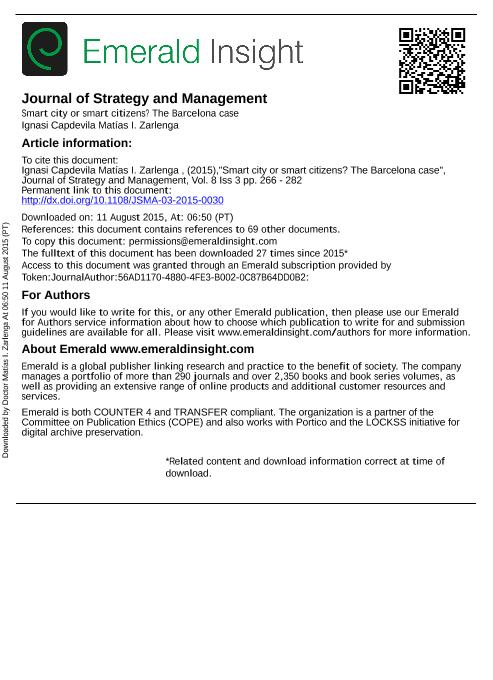Mostrar el registro sencillo del ítem
dc.contributor.author
Capdevilla, Ignasi
dc.contributor.author
Zarlenga, Matías Ignacio

dc.date.available
2018-08-17T21:36:42Z
dc.date.issued
2015-08
dc.identifier.citation
Capdevilla, Ignasi; Zarlenga, Matías Ignacio; Smart city or smart citizens? The Barcelona case; Emerald; Journal of Strategy and Management; 8; 3; 8-2015; 266-282
dc.identifier.issn
1755-4268
dc.identifier.uri
http://hdl.handle.net/11336/56286
dc.description.abstract
Purpose – In recent years, the term “smart city” has attracted a lot of attention from policy makers, business leaders and citizenship in general. Although there is not a unique definition of what a smart city is, it is generally accepted that “smart” urban policies refer to local governments’ initiatives that use information and communication technologies in order to increase the quality of life of their inhabitants while contributing to a sustainable development. So far, “smart city” approaches have generally been related to top-down processes of technology diffusion. The purpose of this paper is to present a broader view on “smart” initiatives to analyze both top-down and bottom-up dynamics in a smart city. The authors argue that these two perspectives are complementary and its combination can reinforce the collaboration between different city stakeholders. Top-down and bottom-up initiatives are not opposed forces but, on the contrary, can have a synergistic effect on the innovation capacity of the city. Both perspectives are illustrated by providing examples of different “smart” aspects in the city of Barcelona: smart districts, open collaborative spaces, infrastructures and open data. Design/methodology/approach – To illustrate the arguments, the authors analyze the case of the city of Barcelona providing examples of top-down and bottom-up initiatives in four different smart city aspects: smart districts, open collaborative spaces, infrastructures and open data. The research method is based on a case study (Yin, 1984). The primary data consisted on interviews to city council representatives as well as managers of local public institutions, like economic development offices, and local organizations like for instance coworking spaces. The authors interviewed also specialists on the innovation history of the city in order to validate the data. In addition, the authors used secondary data such as reports on the 22@, and documentation on the Barcelona innovation policies, as well as doing a compilation of press articles and the online content of the institutional webpages. All together, the authors have followed a data triangulation strategy to seek data validation based on the cross-verification of the analyzed data sources. Findings – The analysis suggests that the top-down and bottom-up perspectives are complementary and their combination can reinforce the collaboration between different city stakeholders. Top-down and bottom-up initiatives are not opposed forces but, on the contrary, can have a synergistic effect on the innovation capacity of the city. Both perspectives are illustrated by providing examples of different “smart” aspects in the city of Barcelona: smart districts, open collaborative spaces, infrastructures and open data. Research limitations/implications – Nevertheless, the analysis has its limitations. Even if the authors have emphasized the importance of the bottom-up initiatives, citizens do not have often the resources to act without governmental intervention. This is the case of services that require high-cost infrastructures or regulatory changes. Also, as it usually happens in the case of disruptive technology, it is hard for citizens to understand the possibilities of its use. In these cases, firms and institutions must play an important role in the first phases of the diffusion of innovations, by informing and incentivizing its use. It is also important to note that some of the emerging usages of technology are confronted to legal or regulatory issues. For instance, distributed and shared Wi-Fi networks might be in opposition to economic interests of internet providers, that often difficult its expansion. It is also the case of services of the sharing economy that represent a menace to established institutions (like the tensions between Uber and taxi companies, or Airbnb and hotels). In these cases, city halls like it is the case in Barcelona, tend to respond to these emergent uses of technology by regulating to ensure protection to existing corporate services. Practical implications – In conclusion, the transformational process that leads a city to become a smart city has to take in consideration the complexity and the plurality of the urban reality. Beyond considering citizens as being users, testers or consumers of technology, local administrations that are able to identify, nourish and integrate the emerging citizens’ initiatives would contribute to the reinforcement of a smart city reality. Originality/value – The contribution of the paper is to go beyond the generalized technologic discourse around smart cities by adding the layer of the citizens’ initiatives.
dc.format
application/pdf
dc.language.iso
eng
dc.publisher
Emerald

dc.rights
info:eu-repo/semantics/openAccess
dc.rights.uri
https://creativecommons.org/licenses/by-nc-sa/2.5/ar/
dc.subject
Bottom-Up
dc.subject
Open Collaborative Spaces
dc.subject
Open Data
dc.subject
Smart Citizens
dc.subject
Smart City
dc.subject
Smart Districts
dc.subject
Top-Down
dc.subject.classification
Negocios y Administración

dc.subject.classification
Economía y Negocios

dc.subject.classification
CIENCIAS SOCIALES

dc.title
Smart city or smart citizens? The Barcelona case
dc.type
info:eu-repo/semantics/article
dc.type
info:ar-repo/semantics/artículo
dc.type
info:eu-repo/semantics/publishedVersion
dc.date.updated
2018-08-16T18:04:39Z
dc.journal.volume
8
dc.journal.number
3
dc.journal.pagination
266-282
dc.journal.pais
Reino Unido

dc.description.fil
Fil: Capdevilla, Ignasi. Paris School of Business; Francia
dc.description.fil
Fil: Zarlenga, Matías Ignacio. Universidad de Barcelona; España. Consejo Nacional de Investigaciones Científicas y Técnicas; Argentina
dc.journal.title
Journal of Strategy and Management
dc.relation.alternativeid
info:eu-repo/semantics/altIdentifier/doi/http://dx.doi.org/10.1108/JSMA-03-2015-0030
dc.relation.alternativeid
info:eu-repo/semantics/altIdentifier/url/https://www.emeraldinsight.com/doi/abs/10.1108/JSMA-03-2015-0030
Archivos asociados
